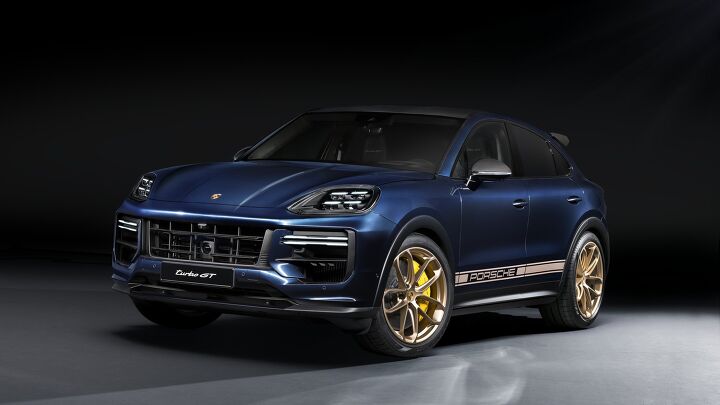2024 Porsche Cayenne Updates: More Power and More Screens

We could debate whether the Cayenne saved Porsche until the cows come home, but there’s no denying the SUV’s appeal and popularity in the automaker’s lineup. The SUV’s getting a refresh for 2024, but it’s not the mild facelift we often see in the industry. Porsche’s giving the Cayenne better powertrains, a revised interior with more screens, and upgraded suspension.
Porsche offers the 2024 Cayenne with three powertrains, starting with the entry-level turbocharged 3.0-liter V6, which makes 348 horsepower and 368 pound-feet of torque. The mid-range Cayenne S now gets a twin-turbo V8 with 468 horsepower and 442 pound-feet of torque, giving it a 4.4-second 0-60 mph time. The Turbo GT gets the twin-turbo V8 with power cranked up to 650 horsepower.
The Cayenne E-Hybrid is sticking around in 2024, and its new electric motor makes 174 horsepower, increasing output to 463. Range estimates for the plug-in Cayenne are on the way, but the battery capacity has been increased from 17.9 to 25.9 kWh. The Cayenne, Cayenne S, and E-Hybrid now come standard with Porsche Active Suspension Management (PASM), which features new shock absorbers. The system can be paired with optional adaptive air suspension, which responds to drive mode selection for better handling and performance.
Though the SUV looks roughly the same as before, Porsche said it touched nearly every exterior body panel, giving the Cayenne new fenders, an updated hood, and reshaped headlights. Three new colors are available, and buyers can add a Lightweight Sport Package that shaves 72 pounds from the hulking family hauler.
Changes to the cabin are impactful and include a shift from analog gauges to a completely digital experience. The SUV gets a 12.6-inch digital gauge cluster and a 12.3-inch center touchscreen. Porsche offers a 10.9-inch passenger display for the first time, which can stream video and other content. A special light filter ensures the driver isn’t distracted by the display.
Porsche installs more safety equipment as standard, including speed limit assist. The optional adaptive cruise control system now offers an evasive driving function and a turn assist function that can help avoid collisions in an intersection.
[Image: Porsche]
Become a TTAC insider. Get the latest news, features, TTAC takes, and everything else that gets to the truth about cars first by subscribing to our newsletter.

Chris grew up in, under, and around cars, but took the long way around to becoming an automotive writer. After a career in technology consulting and a trip through business school, Chris began writing about the automotive industry as a way to reconnect with his passion and get behind the wheel of a new car every week. He focuses on taking complex industry stories and making them digestible by any reader. Just don’t expect him to stay away from high-mileage Porsches.
More by Chris Teague
Latest Car Reviews
Read moreLatest Product Reviews
Read moreRecent Comments
- Redapple2 Do your drinking at home !
- Redapple2 Chicago used to a great town. Shame.
- Redapple2 Why are Tesla sales falling?
- Ras815 It's insane they would go through all of that added expense and time to ship to Italy and back, all for noticeably inferior workmanship on their flagship product. A harbinger of GM's increasingly questionable decision-making, perhaps?
- ChristianWimmer US-spec 380SLs were especially asthmatic thanks to the emissions regulations. In Europe these were considered quite “quick” and powerful. They are slow cars by todays standards but excellent cruisers so this 380SL is perfect for someone who just wants a solid, open-top cruiser and not a weekend drag racer.IIRC the 560SL had a torque advantage over the European 500SL, but the 500SL was ultimately the quicker car.I own an ‘89 500SL R129 and despite the 326-horsepower torquey V8, it’s 0-100 km/h “performance” is held back by the 4-speed automatic and 2-ton weight. Even in their day these cars were not intended for drag racing or 0-100 km/h bragging times. They are cruisers meant to be enjoyed in a responsible manner. Plus, driving faster than 120-130 km/h with the top down or the soft top closed results in high wind noises for the former and a loud fluttering cloth top for the latter. As a result I drive a maximum of 110 km/h on the Autobahn with the top down or 120-130 km/h with the top up.


































Comments
Join the conversation
Coming soon to a neighborhood brothel near you!
Looks like the BMW grille man has been around...